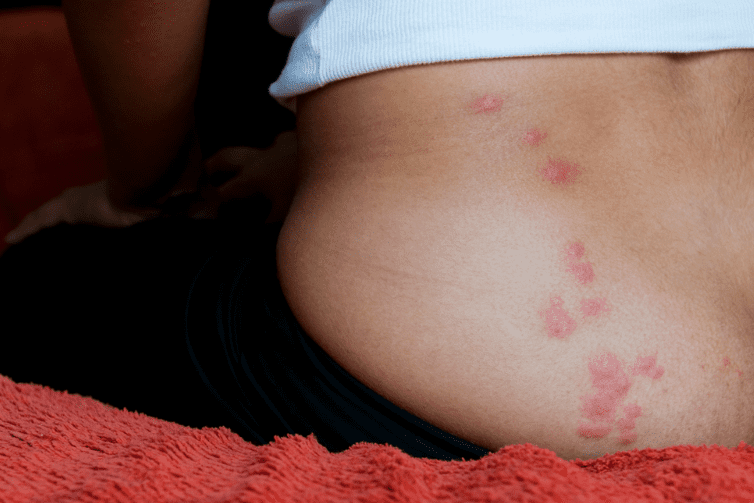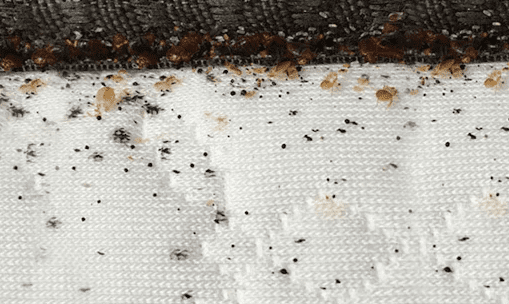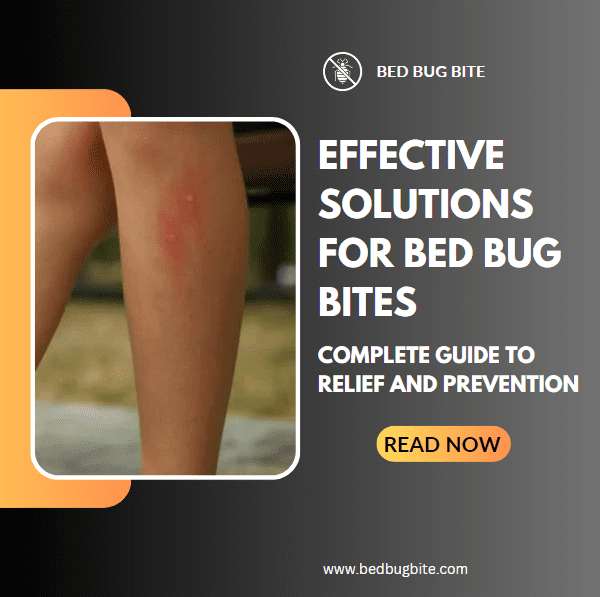Introduction
Welcome to our comprehensive guide on how to combat the nuisance of bed bug bites. A concern shared by many across the globe. Bed bug bites can cause not only physical discomfort through itching and irritation but also lead to significant anxiety and sleep disturbances. Understanding the impact these tiny pests can have on your well-being. Our mission is to provide you with the most effective strategies for treating bed bug bites and preventing their recurrence. Drawing on our vast experience and the latest research, we aim to empower you with knowledge and practical solutions. …Click Now to Read More Bed Bug Facts

Bed bugs are notorious for their stealthy existence, primarily emerging in the cloak of darkness to feed on human blood. These bites often result in red, itchy welts, a distressing reminder of the bed bugs’ presence. Acknowledging the challenge these pests pose, it’s crucial to recognize the signs of their bites and understand the reasons behind their biting behavior.
Effective Solutions for Bed Bug Bites
In this article, we delve into the immediate steps you can take to alleviate the discomfort caused by bed bug bites and explore long-term treatment strategies to ensure your home remains bed bug-free. By adhering to our expert advice, you can rest assured that relief and prevention are within reach.
For further reading on the habits of bed bugs and how they affect humans, the Environmental Protection Agency (EPA) provides an insightful resource that complements our discussion. Here, you’ll find additional context on why bed bugs bite and how to identify an infestation. Information that underscores the importance of tackling both the symptoms and the source of the problem.
Stay tuned as we guide you through a journey from immediate relief to proactive prevention, ensuring you’re equipped with the knowledge to reclaim your peace of mind and comfort in your own home.
Understanding Bed Bug Bites
In our journey to demystify the realm of bed bug encounters, understanding bed bug bites stands as a fundamental step. These bites are often the first sign of an unwelcome infestation, manifesting as small, red, and sometimes swollen spots that itch intensely. Typically appearing in lines or clusters on skin exposed during sleep. They are a distressing evidence of bed bugs’ midnight feasts on human blood. Recognizing these symptoms is crucial for early intervention and preventing a more severe infestation.
What Bed Bug Bites Look Like and Common Symptoms
Bed bug bites are misleadingly similar to other insect bites, but a closer look reveals distinct patterns. These nuisances tend to bite in a straight line or zigzag pattern. Leaving clusters of small, red marks that become increasingly irritating and swollen. Symptoms include redness, swelling, and a burning sensation that may evolve into raised itches or blisters. Some individuals may experience more severe allergic reactions, underscoring the importance of identifying these bites accurately.
Why Bed Bugs Bite: Feeding Habits Unveiled
Bed bugs are mostly nocturnal creatures. Emerging from their hiding spots at night to feed on the blood of their unsuspecting hosts. These pests are attracted to the carbon dioxide humans exhale and the warmth of our bodies, making us their ideal targets. Understanding their feeding habits is pivotal in recognizing the signs of an infestation early. Bed bugs can survive months without feeding, making their detection and eradication a challenge for many.
Equipped with this knowledge, individuals can take proactive steps in identifying bed bug bites and understanding the urgency of addressing the issue. Early recognition of bed bug bites not only alleviates the immediate discomfort but also plays a crucial role in preventing a small issue from escalating into a full-blown infestation. In the next sections, we will explore the effective remedies for immediate relief from bed bug bites and delve into strategies for long-term prevention, ensuring your living environment remains a safe haven free from the clutches of bed bugs.
Immediate Relief for Bed Bug Bites
Upon recognizing the telltale signs of bed bug bites, the next crucial step is seeking immediate relief. The discomfort and itchiness caused by these bites can be quite distressing, urging an urgent need for effective solutions. Thankfully, a range of home remedies and over-the-counter options are available.
Offering both immediate alleviation and aiding in the healing process. By implementing these strategies, individuals can significantly reduce the irritation and risk of infection associated with bed bug bites.
Home Remedies for Soothing Bed Bug Bites
Several household items can provide quick relief from the itchiness and discomfort of bed bug bites. These remedies are easily accessible and can be highly effective:
- Baking Soda Paste: Mixing baking soda with a small amount of water to create a paste and applying it directly to the bites can help neutralize the itchiness due to its anti-inflammatory properties.
- Aloe Vera: Known for its soothing and healing properties. Aloe vera gel can be applied to the bites to reduce redness and swelling.
- Cool Compress: Applying a cool compress or a damp cloth over the bites can offer immediate relief from itching and help reduce inflammation.
Over-the-Counter Solutions
For those seeking more potent relief, several over-the-counter options can be effective:
- Antihistamines: Oral antihistamines can reduce allergic reactions and alleviate itching. Making them a suitable option for those with more severe reactions to bed bug bites.
- Anti-itch Creams: Topical creams containing hydrocortisone can be applied to the bites to lessen itching and prevent the urge to scratch, thereby reducing the risk of infection.
It’s important to note that while these remedies can provide relief, they do not address the root cause of the problem: the bed bugs themselves. Therefore, parallel efforts must be made to identify and eliminate any infestations in your home to prevent future bites. In cases where bites are numerous, severe, or lead to allergic reactions. Consulting a healthcare professional is advisable to prevent complications. As we move forward, we will explore long-term strategies to treat and prevent bed bug infestations. Ensuring that the relief from bed bug bites is not just temporary but part of a comprehensive approach to eradicating bed bugs from your living environment.
Long-Term Treatment Strategies
Addressing the immediate discomfort caused by bed bug bites is crucial. Yet it’s equally important to focus on long-term treatment strategies. These strategies are not only about healing the bites but also about monitoring for potential signs of infection or allergic reactions over time. Furthermore, understanding when professional medical advice is warranted can ensure that individuals do not endure unnecessary suffering or complications. By adopting a proactive and informed approach to treatment, individuals can effectively manage the aftermath of bed bug bites while taking decisive steps to prevent future occurrences.
Monitoring and Identifying the Severity of Reactions Over Time
Vigilance in observing the healing process of bed bug bites is key. It’s essential to monitor any changes in the bites themselves or the body’s reaction to them. This includes watching for signs of increased redness, swelling, or the development of pus, which could indicate an infection. Additionally, if symptoms such as fever, difficulty breathing, or swelling of the face, lips, or tongue occur, these could be signs of a severe allergic reaction requiring immediate medical attention.
Seeking Professional Medical Advice
While home and over-the-counter remedies can be effective for minor symptoms, there are circumstances where seeking professional medical advice is imperative:
- Persistent Symptoms: If bites are not improving with home treatment or if symptoms persist for more than a week, consulting a healthcare provider can help identify any underlying issues or infections that may require more targeted treatment.
- Severe Allergic Reactions: In cases where individuals experience severe allergic reactions to bed bug bites, medical intervention can provide necessary relief and prevent complications. A healthcare provider may prescribe stronger anti-inflammatory or antihistamine medications, or in some cases, corticosteroids.
Understanding the long-term management of bed bug bite reactions is crucial in ensuring that individuals do not suffer in silence or exacerbate their conditions. Alongside treating the physical symptoms, addressing the psychological impact of bed bug infestations, such as anxiety or sleep disturbances, can be part of a holistic approach to recovery. As we move forward, our focus will shift towards preventive measures. By understanding how to identify and eliminate bed bug infestations, individuals can take proactive steps to protect themselves and their homes from future bites. Creating a safer, more comfortable living environment free from the threat of bed bugs.
Preventing Bed Bug Bites in the Future
With immediate relief strategies and long-term treatment options covered. The pivotal next step in our journey against bed bug bites lies in prevention. Preventing bed bug bites not only involves treating existing infestations but also implementing measures to avoid future infestations. This dual approach ensures not only a bed bug-free environment but also peace of mind for individuals concerned about the distress and discomfort bed bug bites can cause. From identifying signs of bed bugs to considering professional extermination. Proactive prevention can significantly reduce the risk of bed bug bites.
Tips for Identifying and Eliminating Bed Bug Infestations
The first line of defense against bed bug bites is recognizing and addressing infestations early. Key signs include:

- Spotting Bed Bugs: Regularly inspect your sleeping areas for signs of bed bugs. Including live insects, rusty-colored blood spots on bedding, and exoskeletons shed by growing bed bugs.
- Immediate Action: Upon discovering an infestation, isolate affected items and clean the area thoroughly. Consider using a high-heat steam cleaner on mattresses, furniture, and other surfaces bed bugs are known to hide in.
Professional Extermination Options
While DIY measures can be effective, sometimes the extent of an infestation requires professional intervention:
- Benefits of Professional Exterminators: Pest control professionals possess the knowledge, tools, and techniques to eradicate bed bug infestations more thoroughly and efficiently than most DIY methods.
- Choosing the Right Professional: It’s crucial to select a reputable and experienced exterminator, ideally one who specializes in bed bug eradication. Ensure they use safe and effective methods by discussing their approach before hiring.
Preventing bed bug bites goes beyond just reacting to visible signs of bed bugs. It encompasses a comprehensive strategy that includes regular inspection, immediate action upon detection, and, if necessary, professional extermination. By adopting these preventative measures, individuals can protect themselves, their families, and their homes from the nuisance and health risks associated with bed bug bites. The journey to a bed bug-free environment is ongoing, and through vigilance and proactive measures, achieving and maintaining this goal is within reach.
DIY Preventive Measures
As we delve further into the realm of prevention. It’s essential to highlight the importance of DIY preventive measures in creating a hostile environment for bed bugs. These steps not only deter bed bugs from making their home in your space but also minimize the chances of future infestations. Implementing protective bedding solutions and maintaining a clean, clutter-free environment are cornerstone practices in this preventive strategy. By adopting these measures, individuals can significantly reduce the likelihood of encountering bed bug bites. Ensuring a safer and more comfortable living space.
Protective Bedding Solutions
One of the most effective ways to prevent bed bug bites is to invest in protective bedding:
- Bed Bug-Proof Mattress Covers and Encasements: These specially designed covers seal off the mattress and box spring. Denying bed bugs access to their favorite hiding spots. Ensure the covers are of high quality and properly fitted to be effective.
- Regular Inspection and Maintenance: Even with protective covers, regular inspections of the bedding and surrounding areas for signs of bed bugs are essential. This practice helps catch any potential infestations early before they spread.
Regular Cleaning Routines
Maintaining a clean and organized environment is critical in preventing bed bug infestations:
- Vacuuming: Frequent vacuuming of floors, furniture, and other areas where bed bugs could hide significantly reduces their numbers and prevents them from establishing a foothold.
- Decluttering: Reducing clutter eliminates potential hiding spots for bed bugs. Making it easier to spot and address any signs of infestation quickly. A minimalist approach to your living space not only aids in bed bug prevention but also contributes to a more peaceful and orderly home environment.
Implementing DIY preventive measures is a proactive step towards safeguarding your home against bed bugs. Protective bedding solutions and a commitment to cleanliness and order can create an unwelcoming environment for these pests. Significantly reducing the risk of infestation and the associated discomfort of bed bug bites. As we move forward, exploring natural and chemical-free repellents will complement these strategies. Offering additional layers of protection in the ongoing battle against bed bugs.
Natural and Chemical-Free Repellents
As we advance our comprehensive guide on combating bed bug bites, it’s pivotal to recognize that prevention extends beyond professional extermination and rigorous cleaning routines. Integrating natural and chemical-free repellents into our daily practices offers a safe, eco-friendly approach to deterring bed bugs. Ensuring our living spaces remain sanctuaries of comfort and safety. By embracing these natural solutions, individuals can contribute to a holistic strategy that not only wards off bed bugs but also maintains a healthy environment for themselves and their loved ones.
Natural and Chemical-Free Repellents Safe for Home Use
In our quest for a bed bug-free home, turning to nature’s bounty provides us with effective tools that are both safe and environmentally friendly:
- Essential Oils: Certain essential oils, like lavender, peppermint, and tea tree oil, are celebrated for their insect-repelling properties. Diluting these oils with water and spraying them around beds and furniture can create a natural barrier against bed bugs.
- Diatomaceous Earth: This naturally occurring powder can be sprinkled in bed bug-prone areas to dehydrate and kill bed bugs over time. It’s a non-toxic option that’s safe for use around pets and children when applied correctly.
Effectiveness and Application
While natural repellents offer a gentler alternative to chemical treatments, their effectiveness can vary:
- Consistent Application: For natural repellents to be effective, regular reapplication is necessary. Creating a routine for spraying essential oils or applying diatomaceous earth ensures that these measures continue to protect against bed bugs.
- Complementary Measures: Natural repellents work best as part of a broader bed bug prevention strategy. Combining these methods with regular cleaning, inspections, and, when necessary, professional interventions can significantly reduce the likelihood of infestations.
Embracing natural and chemical-free repellents not only contributes to a bed bug prevention strategy but also aligns with a commitment to maintaining a healthy, environmentally conscious home. As we conclude our guide, remember that the journey to a bed bug-free environment is a continuous one, requiring vigilance, proactive measures, and a willingness to adapt strategies as needed. By incorporating these natural solutions into your daily routine, you can enhance your defenses against bed bugs, ensuring your home remains a peaceful retreat from the outside world.
Conclusion
As we conclude our comprehensive guide on mitigating the nuisance and discomfort of bed bug bites. It’s evident that the journey towards a bed bug-free environment requires a multifaceted approach. From immediate relief and long-term treatment strategies to preventive measures and natural repellents. Each step plays a crucial role in protecting ourselves and our homes from these persistent pests. The fight against bed bugs is not only about addressing the physical symptoms but also about fostering an environment where these pests cannot thrive. Staying informed, vigilant, and proactive. We can significantly reduce the likelihood of bed bug infestations and the discomfort they bring.
Recap of Essential Steps
Remember, the key to managing bed bug bites effectively lies in:
- Immediate Relief: Utilizing home remedies and over-the-counter treatments to alleviate the discomfort caused by bed bug bites.
- Long-Term Strategies: Monitoring bites for signs of severe reactions and seeking medical advice when necessary.
- Prevention: Regularly inspecting living spaces, employing professional extermination services if needed, and integrating natural repellents into our daily routines.
Staying Vigilant and Proactive
The battle against bed bugs is ongoing. But with the right knowledge and tools at your disposal, maintaining a bed bug-free home is achievable. Regular inspections, cleanliness, and awareness are your best defenses against these unwelcome guests.
Invitation to Share Experiences
We invite you to share your own experiences, tips, or questions in the comments section below. Your insights could provide invaluable support to others navigating similar challenges.
For additional resources and further reading on bed bug prevention and treatment. Reputable sources such as the Environmental Protection Agency (EPA) and the Centers for Disease Control and Prevention (CDC) offer a wealth of information. Their guidance complements the strategies discussed in this guide, empowering you with the knowledge to tackle bed bug issues head-on.
Together, we can turn the tide against bed bugs, ensuring our homes remain safe havens of comfort and peace. Let’s continue to share knowledge, support one another, and stay committed to creating bed bug-free environments for ourselves and our communities.




